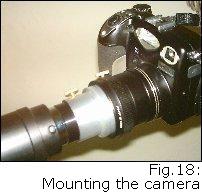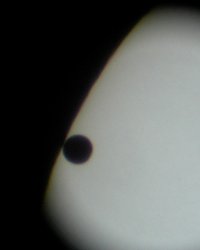 Deutsch Deutsch |
Transit of Venus |
|
Transit of Venus In 2004 at the 8th of June an other astronomical even occurred, which provoked my experience in sun observation. The Venus, which is in approximately as large as the earth, could be seen from 07:19:53 to 13:23:28 o'clock central European summer time (CEST) in front of the sun. Taking the photo I used the filter method for observation. The self made filter holder, I described already, uses a foil of Baader Solar, with an optical density of 3,5 (fig. 17).   Using a self manufactured flange, I mounted my digital camera (Nikon Coolpix 5000) to the telescope directly. Following the illustration from left to right (fig. 18), you see the end of the telescope, where the eyepiece is fastened by a clamping screw (black smallest diameter). On top of the eyepiece I attached the self provided flange (silvery white) where a second adapter is fixed, having a special thread, which fits to the camera. The last part I purchased at a photo shop. With this arrangement I was able to take sharp pictures directly through the telescope. The camera is able to take pictures up to a minimum distance of 20 mm, which is a good approach to normal observation by the eye. The Coolpix 5000 is provided with a display with 1.5"size, you can rotate by 180 degrees, so "observation acrobatics" are limited when taking the photographs. Nevertheless it is a problem using that medium sized display to evaluate a high image definition. In order to control the quality of focus, I transferred the pictures to a mobile computer occasionally. This requires a switching from recording- to display-mode at the camera directly and in addition a readjusting of the telescope was inevitable. Venus in front of Sun June 8th 2004 Here a selection of the pictures, I shot in this morning. To enlarge them, please click on the pictures itself. Attention large file sizes! (approx. 1.2 MB) The two pictures developed at 11:36 o'clock (left) and at 12:44 o'clock CEST (right) show the Venus in front of the sun. Almost half of the sun disk can be seen and the planet stands out clearly as a black disk on the sun background. You recognize that the planet moves at the photo approximately 3 cm from top right down to the left within an hour. Compared to the transit of Mercury the Venus in reality runs at the Southern Hemisphere of the sun. My photos however show the mirror-wrong representation of a telescope. The two next pictures show the end of the transit. Fig. 21 was taken at the so called "contact 3" (T3 = 13:03 o'clock Central European Summer Time). Here the outer boundary of the planet meets the inside margin of the sun disk. For enlargement of the picture, please click on it, but keep in mind, that file size is about 0.5 MB At 13:13 o'clock Central European Summer Time (fig. 22) the half Venus disk is to be seen still. If the outer boundary of planet and Sun meet, you talk about "contact 4" (t4). This time cannot be determined accurately by a normal telescope, since the planet stands out hardly in the weakly shining corona of Sun. For this task a coronagraph is better suitable. The contact times t1 and t2 for the beginning of the planet transit are defined in the same way. The accurate times I took from literature, like: t1 = 07:19:44, t2 = 07:39:22, t3 = 13:03:31, t4 = 13:23:23 o'clock, all times relate to Central European Summer Time (CEST). In contrary to my photos of the Mercurytransit in (2003), the pictures of Venus in front of the sun-disk have a notably better quality. One reason may be the direct observation by the filter-method. Thus the desire arose to draw further astronomical conclusions from the pictures, e.g. the question: Which diameter does the Venus have actually? Read on: Determination of Venus diameter Back to the start of page |
|
| Copyright by Hans Joachim Ilgen since 1950 | |



